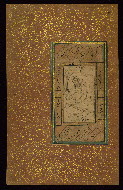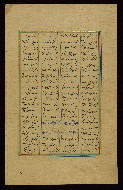Home > Digitized Walters Manuscripts
This document is a tranformation of a TEI P5 XML manuscript description incorporating images. If you have trouble reading special or non-Latin characters on this page, please make sure you have appropriate Unicode fonts installed and an up-to-date web browser.
Walters Ms. W.686, Single leaf of an old man kneeling
Browse images (Browse images in a new window) | TEI in XML format
W.686
Single leaf of an old man kneeling
This Safavid drawing of an old bearded man is inscribed with the name of the famous Persian artist Riz̤ā–yi ʿAbbāsī (d. 1044 AH / 1634 CE). The name of the artist, written in black nastaʿlīq script, appears in the lower right corner of the page. It was produced in the middle of the eleventh century AH / seventeenth CE in Iran. Such drawings are often framed by poetic verses. This example is surrounded by panels of verses from a poem by ʿAbd al-Raḥmān Jāmī (d. 898 AH / 1492 CE). It has been suggested that the man depicted is meant to represent the poet Jāmī himself.
Mid 11th century AH / 17th CE
Iran
As-written name: Riz̤ā–yi ʿAbbāsī
Name, in vernacular: رضاى عباسى
Note: Attribution is spurious (see bibliography, Canby)
Leaf
Literary -- Poetry
The primary language in this manuscript is Persian.
Paper
Mounted on pasteboard; back has verses in nastaʿlīq script in four columns
Foliation: Not applicable
17.5 cm wide by 28.5 cm high
- Image: 5.0 cm wide by 8.7 cm high
- Title: Old man kneeling
- Scribe: Riz̤ā–yi ʿAbbāsī
- Text note: Name of artist written in black nastaʿlīq script in lower right corner
- Hand note: Written in black nastaʿlīq script
- Decoration note: Border of gold-sprinkled brown paper
fol. W.686a:

- Title: Old man kneeling
- Form: Drawing
- Label: This Safavid drawing of an old bearded man is inscribed with the name of the famous Persian artist Riz̤ā–yi ʿAbbāsī (d. 1044 AH / 1634 CE). The name of the artist, written in black nastaʿlīq script, appears in the lower right corner of the page. It was produced in the middle of the eleventh century AH / seventeenth CE in Iran. Such drawings are often framed by poetic verses. This example is surrounded by panels of verses from a poem by ʿAbd al-Raḥmān Jāmī (d. 898 AH / 1492 CE). It has been suggested that the man depicted is meant to represent the poet Jāmī himself.
fol. W.686b:
Walters Art Museum, 1931, by Henry Walters bequest
Canby, Sheila R. The Rebellious Reformer: The Drawings and Paintings of Riza-yi Abbasi of Isfahan. (London: Azimuth, 1996), 205.
Stchoukine, I. Les peintures des manuscrits de Shah 'Abbas Ier à la fin des Safavis. (Paris: Beyrouth, 1964), 129.
Noel, William, and Daniel Weiss, eds. The Book of Kings: Art, War, and the Morgan Library's Medieval Picture Bible. (Baltimore: the Walters Art Museum, 2002), 205.
Grube, Ernst J., and Maria Alberta Fabris. Muslim Miniature Paintings from the XIII to XIX Century from Collections in the United States and Canada: Catalogue of the Exhibition. (Venezia: N. Pozza, 1962), 126.
Principal cataloger: Gacek, Adam
Catalogers: Landau, Amy; Smith, Sita
Editor: Bockrath, Diane
Conservators: Jewell, Stephanie; Quandt, Abigail
Contributors: Barrera, Christina; Emery, Doug; Herbert, Lynley; Noel, William; Simpson, Shreve; Tabritha, Ariel; Toth, Michael B.; Valle, Chiara
The Walters Art Museum
Licensed for use under Creative Commons Attribution-NonCommercial-ShareAlike 3.0 Unported Access Rights, http://creativecommons.org/licenses/by-nc-sa/3.0/legalcode. It is requested that copies of any published articles based on the information in this data set be sent to the curator of manuscripts, The Walters Art Museum, 600 North Charles Street, Baltimore MD 21201.
